Best Time to Plant a Tree: Expert Tips for Year-Round Success
- February 6, 2024
- 0 comment
Learn the best times to plant trees and follow expert tips for a healthy, thriving garden. Practical advice for gardeners of all levels. Understanding the optimal planting times and maintenance practices is crucial for the success of any garden. This guide offers practical advice on when to plant trees and how to care for them, ensuring their healthy growth and integration into your garden.

Tailored for gardeners at any experience level, our tips aim to enhance the vitality of your outdoor space, providing a solid foundation for your gardening endeavors.
List of Best Time to Plant a Tree
- The Science of Seasons and Tree Planting
- Decoding the Best Time to Plant Different Types of Trees
- Regional Considerations and Microclimates
- Soil Science and Preparation Techniques
- Advanced Planting Techniques
- Post-Planting Care and Maintenance
- Long-Term Growth and Garden Integration
- Conclusion
- FAQs
The Science of Seasons and Tree Planting
Why Timing Matters
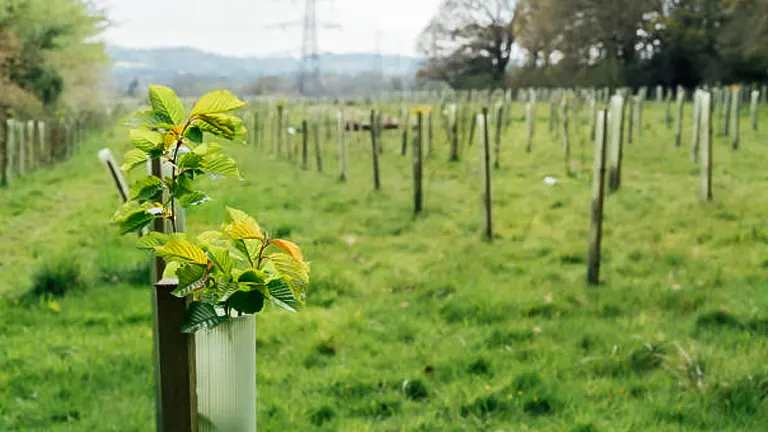
Trees, like all living organisms, follow a life cycle influenced by the seasons. Planting at the wrong time can stress trees, making them more susceptible to disease, pests, and environmental conditions. Conversely, choosing the optimal planting time aligns with the natural growth cycles of trees, promoting stronger root development and better establishment in your garden.
Overview of Seasons
- Spring: Traditionally considered the best time for planting, spring offers moderate temperatures and ample rainfall, encouraging root growth before the stress of summer heat. It’s ideal for both deciduous and evergreen trees, though early spring is best for the latter to establish before growing season.
- Summer: While not the ideal planting season due to high temperatures and potential drought, some drought-tolerant species can still be successfully planted. The key is ensuring adequate water and protection from the intense sun.
- Fall: Many experts favor fall for planting trees. The soil is still warm, encouraging root growth, but the cooler air reduces the demand on the young tree’s foliage and stems, leading to better establishment.
- Winter: In mild climates where the ground does not freeze, winter can be a suitable time to plant dormant trees. This period allows them to establish roots in preparation for spring growth.
Decoding the Best Time to Plant Different Types of Trees
Understanding the differences between tree types is essential for successful planting. Each category has its own ideal timing, influenced by growth habits and environmental needs.
| Tree Type | Best Time to Plant | Key Considerations |
|---|---|---|
| Deciduous Trees | Fall | Cooler temps allow root establishment without the stress of leaf growth. |
| Evergreen Trees | Early Spring or Fall | Moderate temps help root systems establish, avoiding extreme weather stress. |
| Fruit Trees | Early Spring (after last frost) | Requires period of dormancy; plant before bud break for root establishment. |
| Exotic and Tropical Trees | Late Spring or Early Summer | Require consistent warmth; protect from cooler nights early in the season. |
When planning to enrich your garden with new trees, timing is a critical factor that can significantly impact the success of your planting endeavors. Each type of tree—deciduous, evergreen, fruit, and exotic—has its own ideal planting season influenced by its unique biological needs and environmental sensitivities.
Deciduous Trees
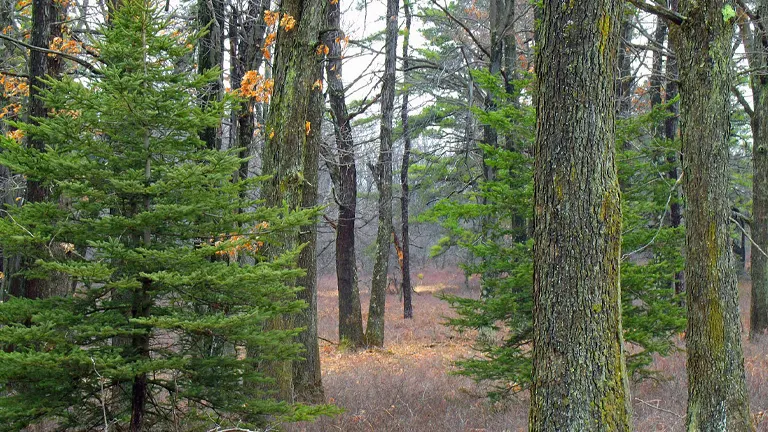
These trees, known for shedding their leaves annually, thrive when planted in the fall. The cooler temperatures allow the roots to establish without the stress of supporting new leaf growth. Planting in the fall also takes advantage of the moisture and temperature conditions favorable for root development before the ground freezes.
Examples:
- Maple Trees (Acer): Known for their spectacular fall colors, maples are a popular choice for many gardens. They come in various sizes and can adapt to a wide range of soil types.
- Oak Trees (Quercus): Oaks are valued for their strength and longevity, offering dense shade in the summer. They are vital for wildlife, providing habitat and food sources.
- Birch Trees (Betula): With their distinctive bark and graceful foliage, birch trees add interest to any landscape. They prefer cooler climates and moist, well-drained soils.
Evergreen Trees
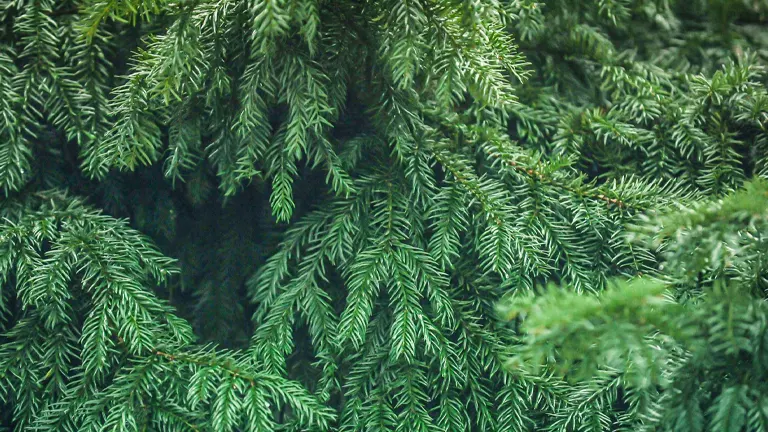
Evergreens, which retain their foliage year-round, benefit from being planted in early spring or fall. This timing allows them to establish their root systems in moderate temperatures, avoiding the extremes of summer heat or winter cold.
Examples:
- Pine Trees (Pinus): Pines are versatile evergreens that come in many forms, from towering giants to low-growing varieties. They thrive in well-drained soil and full sun.
- Spruce Trees (Picea): Spruces are cold-hardy evergreens with a classic conical shape, making them popular as both landscape trees and Christmas trees.
- Cedar Trees (Cedrus): Cedars are known for their aromatic wood and attractive, spreading branches. They prefer sunny locations and well-drained soil.
Fruit Trees
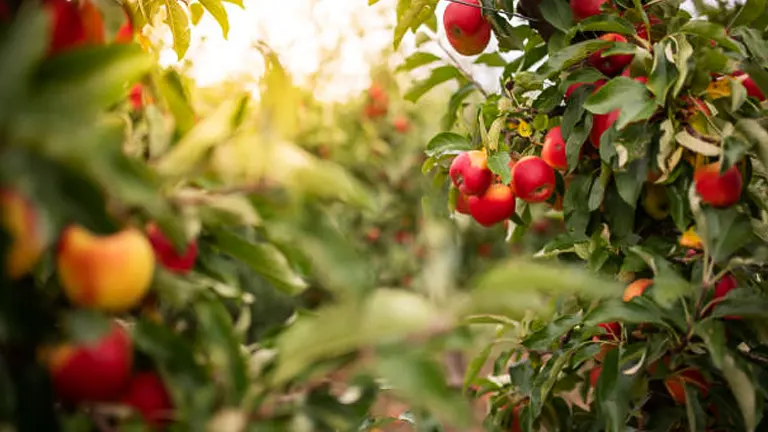
Fruit trees have specific climatic needs that must be considered, often requiring a period of dormancy in winter followed by a burst of spring growth. Early spring, after the last frost but before bud break, is typically the best time. This allows the trees to establish roots before expending energy on fruit production.
Examples:
- Apple Trees (Malus domestica): A favorite for their spring blossoms and fall fruit, apple trees require cross-pollination for fruit production, so planting more than one variety is beneficial.
- Cherry Trees (Prunus avium for sweet cherries, Prunus cerasus for sour cherries): Cherries bloom early in spring, with the fruit ripening in early summer. They need well-drained soil and plenty of sun.
- Peach Trees (Prunus persica): Peaches thrive in warmer climates and require a certain number of chilling hours to produce fruit. They need full sun and well-drained soil.
Exotic and Tropical Trees
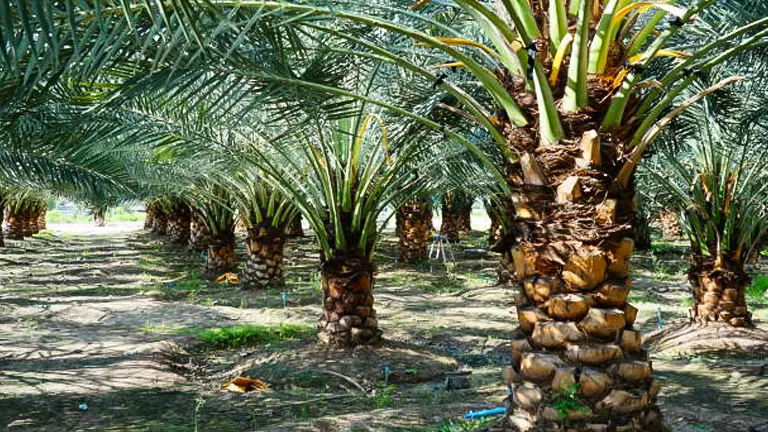
For gardeners in warmer climates planting exotic or tropical trees, the timing might shift towards late spring or early summer, after any threat of cool temperatures has passed. These trees often require consistent warmth to thrive and may need protection from cooler nights early in the season.
Examples:
- Mango Trees (Mangifera indica): Mangoes are a staple in tropical landscapes, requiring warm conditions year-round. They need plenty of space to grow and thrive in full sun.
- Avocado Trees (Persea americana): Popular in home gardens, avocados need frost-free environments and rich, well-drained soil to produce fruit.
- Palm Trees (various genera): Palms symbolize the tropics, with numerous species adapted to different environments. They generally require warm climates, though some are surprisingly cold-hardy.
Understanding these guidelines can help gardeners make informed decisions, ensuring that their trees not only survive but thrive, contributing to a healthy, vibrant garden ecosystem. By aligning your planting activities with the natural cycles and needs of your chosen trees, you’ll enhance the beauty and biodiversity of your outdoor space.
Regional Considerations and Microclimates
The success of tree planting is also heavily influenced by the garden’s location, including the broader climate zone and specific microclimates within the garden itself.
- Understanding Your Zone: The USDA Hardiness Zone Map is a critical tool for gardeners, indicating the most suitable plants for their area’s climate. Knowing your zone helps determine the best planting times for different tree species, taking into account the local weather patterns and temperature ranges.
- Adjusting for Microclimates: Microclimates are small areas within a garden where conditions vary from the general climate, influenced by factors like shading, wind protection, or proximity to buildings. Observing these nuances allows gardeners to fine-tune planting locations and times for better tree establishment.
- Research Local Soil Conditions: Different soil types—from sandy to clay—offer unique advantages and challenges for tree growth. A soil test will reveal pH, nutrient deficiencies, and whether amendments are needed to create an environment where trees can flourish. Understanding your soil type helps in selecting tree species adapted to thrive in those specific conditions.
- Consider Elevation: Elevation affects climate conditions such as temperature and wind exposure. Trees at higher elevations need to withstand cooler temperatures and possibly stronger winds. Selecting species known for their hardiness in these conditions will increase the chances of successful tree growth and survival.
- Factor in Urban Heat Islands: Urban areas can create microclimates that are warmer than their rural counterparts. This phenomenon, known as the urban heat island effect, means that urban gardeners might consider planting trees that are suited to a slightly warmer zone than the surrounding countryside suggests.
- Water Availability: In regions with limited rainfall or water use restrictions, choosing drought-resistant trees becomes essential. These species require less water and are more suited to survive in arid conditions or under water-saving regulations.
- Wildlife and Pest Considerations: Local fauna, from insects to larger animals, can impact the health and survival of newly planted trees. Opting for species that are resistant to local pests and diseases—and employing protective measures for young trees—can mitigate these risks.
- Pollination Partners: Many fruit-bearing trees require a second, compatible variety nearby to ensure cross-pollination and fruit production. Understanding the pollination requirements of your chosen fruit trees, including bloom times and compatible varieties, is crucial for a fruitful harvest.
- Wind Exposure: Trees in windy areas need to be resilient. Planting trees with strong root systems and incorporating windbreaks can shield younger, more vulnerable trees as they establish. This not only protects the trees but also reduces the risk of wind damage to your property.
- Shade Tolerance: Not all trees require full sun; some thrive in partial or full shade. Recognizing the light conditions in your garden allows you to select species that will grow well in the available light, ensuring that each tree has the best conditions for growth.
- Seasonal Extremes: Beyond the average climate conditions of your region, consider the potential for extreme weather events. Trees selected should be capable of surviving the hottest and coldest temperatures your area may experience.
- Local Regulations and Invasiveness: Before planting, check for any local guidelines or restrictions related to trees. Some species may be prohibited due to their invasive nature or susceptibility to disease. Planting approved, non-invasive species helps maintain local biodiversity and prevents the spread of pests and diseases.
- Community and Neighbor Considerations: The impact of your trees on neighbors and the wider community should be considered. Tree selection and placement should be done thoughtfully to avoid conflicts over shading, root intrusion, and litter from leaves or fruit.
Soil Science and Preparation Techniques
The foundation of successful tree planting lies in understanding and preparing the soil. This section covers the critical steps of soil testing, amendment, and site preparation.
Soil Testing and Amendment
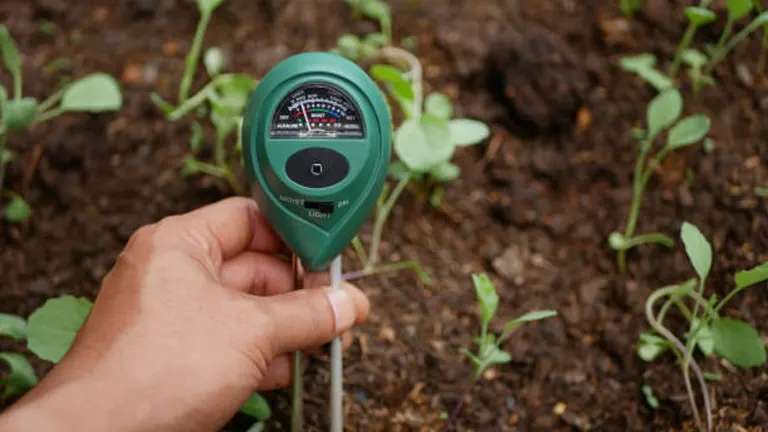
Before planting, conduct a soil test to determine pH levels and nutrient content. Based on the results, you may need to amend the soil with organic matter, compost, or pH adjusters to create the optimal environment for your tree’s growth.
Pro Tips:
- Incorporate a layer of natural mulch after planting to help maintain moisture levels and add organic matter as it decomposes.
- Use a soil amendment like gypsum to improve the structure of clay soils without altering pH, enhancing drainage and root penetration.
The Right Foundation
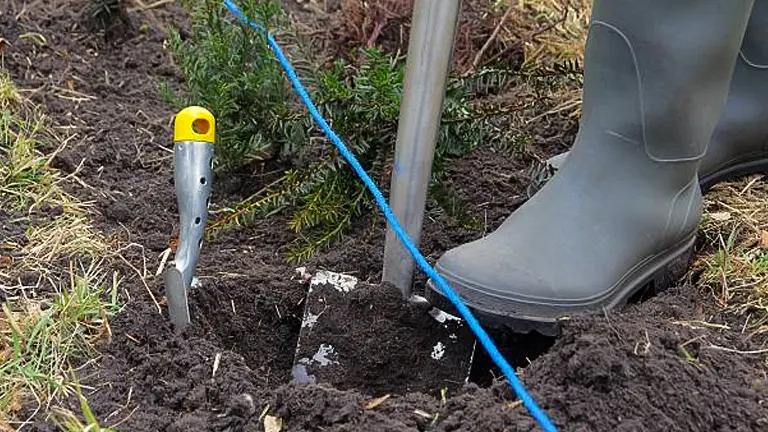
Digging the right hole is just as crucial as choosing the right tree. The hole should be twice as wide as the root ball but no deeper, allowing room for the roots to spread without suffocating. Proper backfilling and initial watering set the stage for healthy growth.
Pro Tips:
- Place the tree at the correct height, ensuring the top of the root ball is level with or slightly above the surrounding soil to prevent water pooling.
- For trees planted from containers, gently tease out the roots if they are circling the root ball to encourage them to grow outward into the surrounding soil.
Watering and Drainage
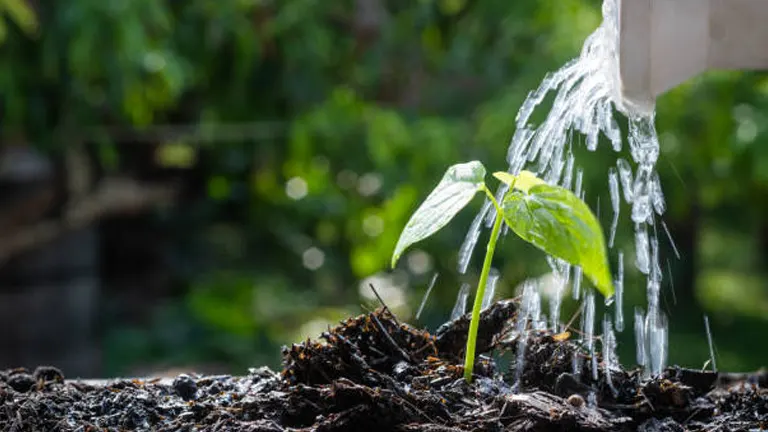
Ensuring adequate moisture and drainage from the start helps young trees establish themselves. A slow, deep watering method encourages roots to grow downward, seeking moisture, which promotes stability and drought resistance over time.
Pro Tips:
- In the first few weeks, water new trees every other day unless rainfall is sufficient, then gradually reduce frequency to encourage deep root growth.
- Install a drip irrigation system or use a soaker hose around the base of the tree to provide slow, deep watering that reaches the root zone without wasting water.
Advanced Planting Techniques
Choosing the right tree involves more than just picking a species; it also requires selecting the right form of tree for planting. Each form—bare-root, balled-and-burlapped, and container-grown—has its own set of guidelines for planting.
Bare-Root Trees
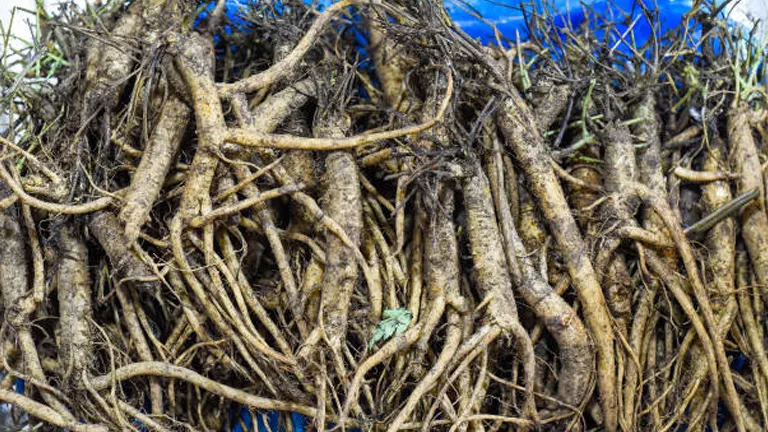
Bare-root trees are sold without soil around their roots, making them lightweight and easier to inspect and plant. The best time to plant bare-root trees is in late winter or early spring before they break dormancy. Soaking the roots in water for a few hours before planting can help ensure they don’t dry out.
Pro Tips:
- Soak bare-root trees in a bucket of water with added seaweed extract to reduce transplant shock and stimulate root growth.
- Trim any damaged or excessively long roots with sharp, clean shears before planting to promote healthy new growth.
- Create a cone of soil in the center of the planting hole to spread the roots over, ensuring even distribution and depth.
- After placing the tree in the hole, fill halfway with soil and water thoroughly to settle the soil around the roots before filling the hole completely.
- Apply a thin layer of mulch around the base of the tree, keeping it away from the trunk to prevent rot and discourage pests.
- Stake bare-root trees temporarily to prevent wind rock, which can damage new root growth, but ensure stakes are removed after one year to avoid dependency.
- Monitor soil moisture closely for the first season, as bare-root trees may need more frequent watering to establish.
Balled-and-Burlapped Trees
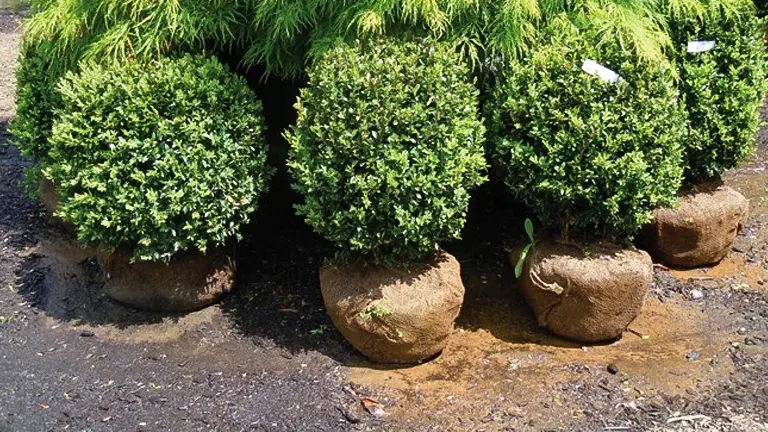
These trees come with their root system wrapped in burlap, often held together by a wire cage. They can be planted in both spring and fall, taking care not to disturb the root ball when planting. It’s essential to remove or cut away the burlap and any wire to prevent root girdling as the tree grows.
Pro Tips:
- Gently loosen the burlap at the top of the root ball and pull it back from the trunk without removing it entirely from under the tree to maintain the integrity of the root ball during planting.
- Before planting, hydrate the root ball thoroughly by soaking it in water until it’s fully saturated, ensuring the roots are moist at planting time.
- If the burlap is synthetic or treated, it must be removed completely, as it won’t decompose naturally in the soil.
- Cut away any visible wire cages to the depth of the planting hole to prevent root constriction as the tree grows, but do so carefully to avoid disturbing the root ball.
- After placing the tree in the hole, ensure it’s planted at the same depth it was growing previously—look for a change in bark color as a guide.
- Backfill the hole with native soil rather than rich compost to encourage roots to expand into the surrounding soil for nutrients and moisture.
- Water the tree deeply immediately after planting, then mulch around the base with organic material to conserve moisture and regulate soil temperature, keeping mulch away from the trunk.
- Use stakes for stability if the tree is large or the site is exposed, but ensure they’re positioned to allow some movement and removed after the first growing season to encourage strong trunk development.
Container-Grown Trees
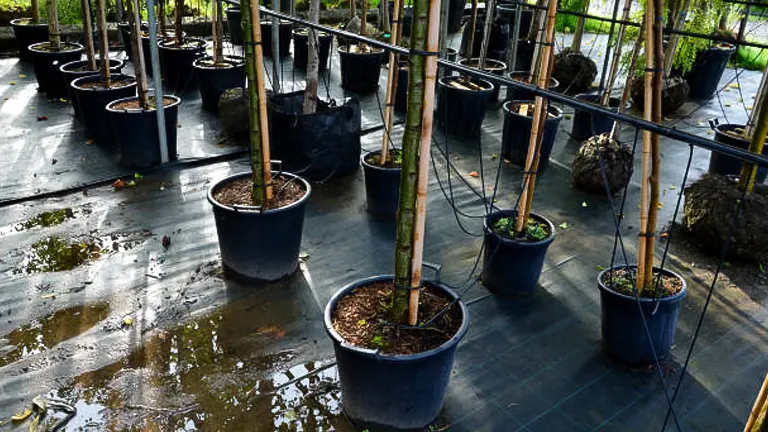
Container-grown trees can be planted throughout the growing season if care is taken to keep them well-watered. When planting, it’s crucial to loosen the root ball to encourage roots to spread into the surrounding soil, breaking up any circling roots to prevent girdling.
Pro Tips:
- Before removing the tree from its container, water it thoroughly to ensure the root ball is moist, making it easier to work with and reducing transplant shock.
- Inspect the root system for circling or girdling roots and gently tease them apart. If roots are densely packed, make vertical cuts along the sides of the root ball to encourage outward growth.
- For trees that have become root-bound in their containers, consider scoring the root ball with a knife in a few places to stimulate new root growth outward into the surrounding soil.
- Place the tree in the planting hole so that the top of the root ball is level with or slightly above the ground level to account for settling and to prevent water from pooling around the trunk.
- Fill the planting hole with the same soil that was removed; resist the temptation to replace it with a richer mix, as this can discourage roots from spreading beyond the planting hole.
- After planting, create a water well or basin around the base of the tree to direct water to the root zone and encourage deep watering that reaches the lower root system.
- For the first few weeks after planting, water the tree every other day (unless there is significant rainfall), then gradually reduce the frequency to encourage deeper root growth.
- Apply a 2- to 3-inch layer of mulch around the tree, extending out to the drip line but avoiding contact with the trunk to minimize the risk of moisture-related diseases and to suppress weed growth.
- Monitor the tree for signs of stress or dehydration, especially during hot, dry periods, and adjust watering accordingly to maintain consistent soil moisture levels.
Post-Planting Care and Maintenance
After planting, the care given during the first few years of a tree’s life will significantly influence its health, shape, and strength.
First-Year Essentials
The first year is all about establishing roots, with particular attention to watering. Trees need regular, deep watering to encourage deep root growth. Avoid fertilizing newly planted trees for the first year to prevent burning the roots; instead, focus on maintaining soil moisture and mulching to conserve it.
Seasonal Maintenance
Each season requires specific maintenance tasks to support the health of your tree:
- Spring: Inspect for damage or disease from winter, begin regular watering, and apply mulch to retain moisture.
- Summer: Continue deep watering, especially during hot, dry periods. Monitor for pests and diseases.
- Fall: Reduce watering as the tree prepares for dormancy. Apply a layer of mulch to protect roots in winter.
- Winter: In cold climates, ensure young trees are protected from frost and breakage under snow load.
Maintenance Tips:
- Regular Watering: Newly planted trees require consistent moisture to establish their root systems. Water deeply once a week, allowing the soil to moisten thoroughly. This deep watering encourages roots to grow downward, promoting stability and drought resistance. Adjust the frequency based on weather conditions, soil type, and tree species.
- Mulching: Apply a 2-3 inch layer of organic mulch around the base of the tree, extending to the drip line but avoiding direct contact with the trunk. Mulch helps retain soil moisture, regulates soil temperature, and reduces weed competition. It also breaks down over time, adding organic matter to the soil.
- Staking When Necessary: If the tree is tall, has a thin trunk, or is in a windy location, staking may be necessary for the first year to provide stability. Use flexible ties and allow for some movement to encourage the trunk to strengthen. Remember to remove stakes and ties after one year to avoid girdling and to promote independence.
- Pruning: Initial pruning should be minimal, focusing on removing any broken, dead, or diseased branches. As the tree matures, yearly pruning can help shape the tree, improve air circulation, and remove unhealthy growth. Always prune with clean, sharp tools to make precise cuts.
- Fertilizing Appropriately: Wait until the second year after planting to fertilize, as new trees need time to adjust without the stress of rapid growth. Use a balanced, slow-release fertilizer suited to the tree species and local soil conditions. Soil tests can guide the type and amount of fertilizer needed.
- Protecting from Pests and Diseases: Regularly inspect your tree for signs of pests or diseases. Early detection is key to managing potential issues. Use environmentally friendly options whenever possible, and consider consulting a professional if you’re unsure of the best treatment.
- Weed and Grass Control: Keep the area around the tree free from grass and weeds, which can compete with the young tree for nutrients and water. Hand-pulling or mulching are effective, non-chemical methods of control. Avoid using weed trimmers near the tree trunk, as they can cause damaging wounds.
- Winter Protection: In colder climates, young trees may need protection from frost, snow, and cold winds. Wrapping the trunk with tree guards can prevent frost cracks and rodent damage. Burlap screens can shield trees from drying winds, and mulching helps insulate the root zone.
- Adjusting Care as the Tree Grows: As trees mature, their care needs will evolve. Monitor growth, health, and the surrounding environment to adjust watering, fertilization, and pruning practices accordingly. Mature trees may require less frequent but deeper watering, and their fertilization needs may change based on growth and soil tests.
- Observing and Enjoying: Regularly take time to observe your tree closely, noting any changes in growth, leaf color, or signs of stress. This active engagement not only helps in early detection of issues but also allows you to enjoy the progress and contributions of your tree to the garden ecosystem.
Common Pests and Diseases
Early detection and treatment of pests and diseases are crucial for the health of your tree. Regular inspections and consulting with local extension services or arborists can help identify and manage common issues.
Long-Term Growth and Garden Integration
As trees mature, they become central figures in the garden landscape, influencing design and ecosystem dynamics.
Planning for Growth
Consider the tree’s mature size when planting to ensure it has enough space to grow both above and below ground. Think about how the tree will shade the garden and what that means for other plants in your design.
Companion Planting
Selecting underplantings that complement your tree can enhance biodiversity and the beauty of your garden. Choose species that thrive in the conditions created by your tree, considering factors like shade and soil moisture.
Sustainability Practices
Incorporating sustainable practices, such as using native species, conserving water, and encouraging wildlife, contributes to a healthy, resilient garden ecosystem. Trees play a vital role in this system, providing benefits that extend well beyond their immediate surroundings.
Conclusion
In conclusion, the essence of cultivating a thriving garden rests on the timing and technique of planting trees. Mastering the seasonal nuances and providing the right care from the start lays the foundation for robust growth and a resilient garden. It’s not just about when you plant, but how you nurture these living investments that determines their success in your landscape. Armed with knowledge and foresight, any gardener can turn the act of planting a tree into a legacy, enriching not just their own outdoor space but the environment at large. Remember, the right time to plant a tree is now, with the right methods ensuring its growth and prosperity for years to come.
FAQs
- Why is fall often considered the best time to plant trees?
Fall provides cooler temperatures and sufficient moisture that allow tree roots to establish before winter, making it an ideal planting season. The reduced heat stress and decreased competition from weeds also contribute to a better start for the newly planted trees. - Can I plant trees in the spring?
Yes, spring planting is beneficial, especially after the last frost has passed. This season offers a warm start for trees to establish roots before the summer heat, making it a suitable time for many species, particularly those sensitive to cold. - Is it ever okay to plant trees in the summer?
While summer is not the ideal time due to heat stress and the high water demand, it’s possible with careful selection of drought-tolerant species and ensuring adequate watering and care to help the tree establish. - What precautions should I take when planting trees in the winter?
In regions with mild winters, you can plant trees during this season. However, avoid planting when the soil is frozen, and choose days when the ground is workable. Winter-planted trees may require less water initially but monitor for dry spells. - How do I know if my soil is ready for planting a tree?
Conduct a soil test to check for pH level, nutrients, and drainage quality. Amend the soil as needed based on the test results to create an optimal growing environment for your tree. - Do different types of trees have specific planting times?
Yes, deciduous trees are best planted in the fall, while evergreens and fruit trees often do better with spring planting. Tropical and exotic trees prefer late spring or early summer to ensure they’re not exposed to any cold. - How does my climate zone affect tree planting times?
Your USDA Hardiness Zone can dictate the best planting times, as it reflects the local climate, frost dates, and temperature extremes. Adjust planting times based on your specific zone’s recommendations for the best tree growth outcomes. - What is the most crucial factor for tree survival after planting?
Proper watering is critical, especially in the first year after planting. Establish a consistent watering schedule to ensure deep root growth, and adjust based on rainfall, season, and tree type to prevent both overwatering and underwatering.
Finding the right moment to plant your trees is crucial for a flourishing garden. Whether in the gentle days of fall or the brisk beginnings of spring, each season offers a unique opportunity for growth. With the right care and timing, your garden will thrive, proving that the best time to plant a tree is indeed now. Embrace this journey, and let your garden’s success be a testament to your efforts.

Benjamin Brooks
Forestry AuthorGreetings! I'm Benjamin Brooks, and my journey over the past 15 years has revolved around the fascinating realms of content creation, expertise in snow clearing, and the intricate world of lumberjacking and landscaping. What began as a simple curiosity about the natural world and heavy machinery has evolved into a passionate profession where my love for crafting words intertwines seamlessly with my lumberjacking and garden skills.








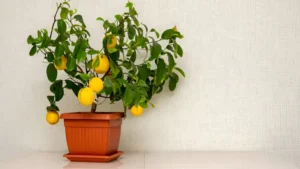




Leave your comment